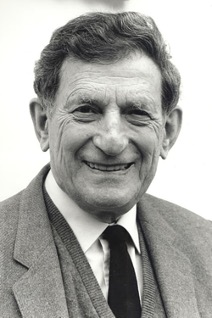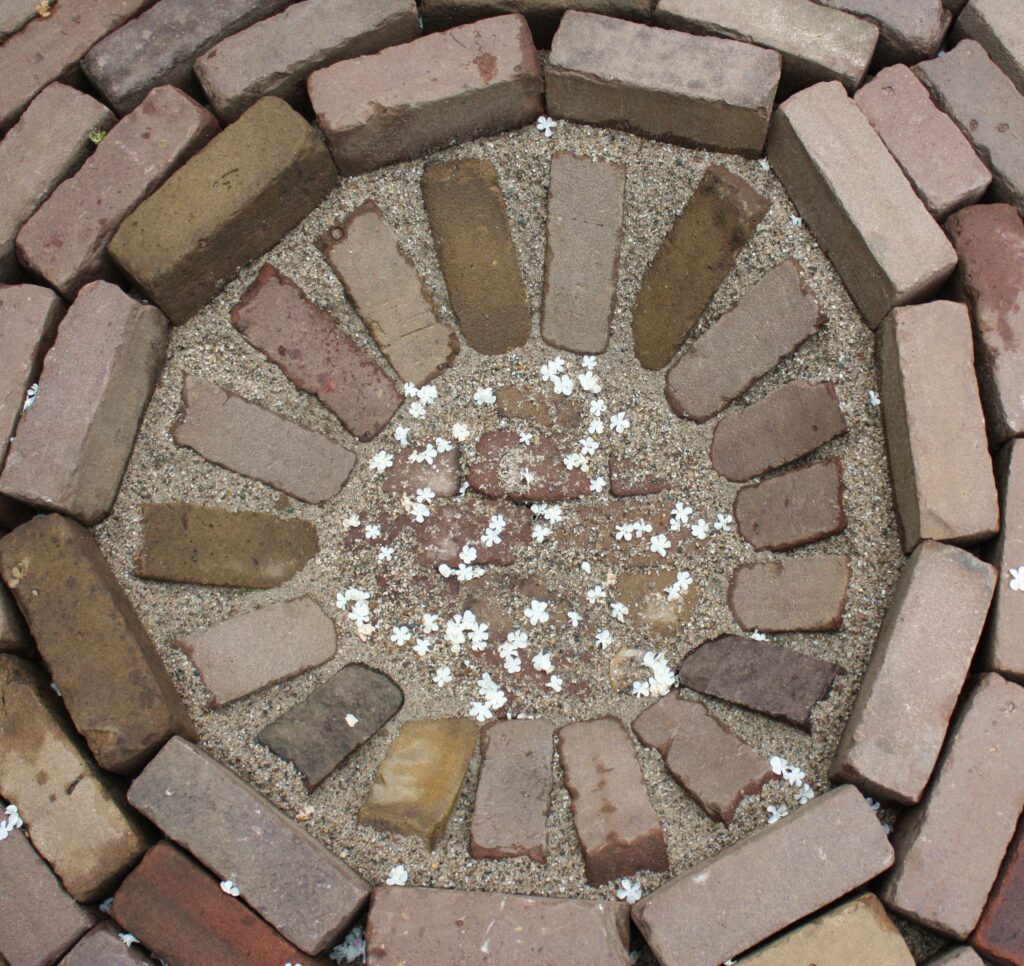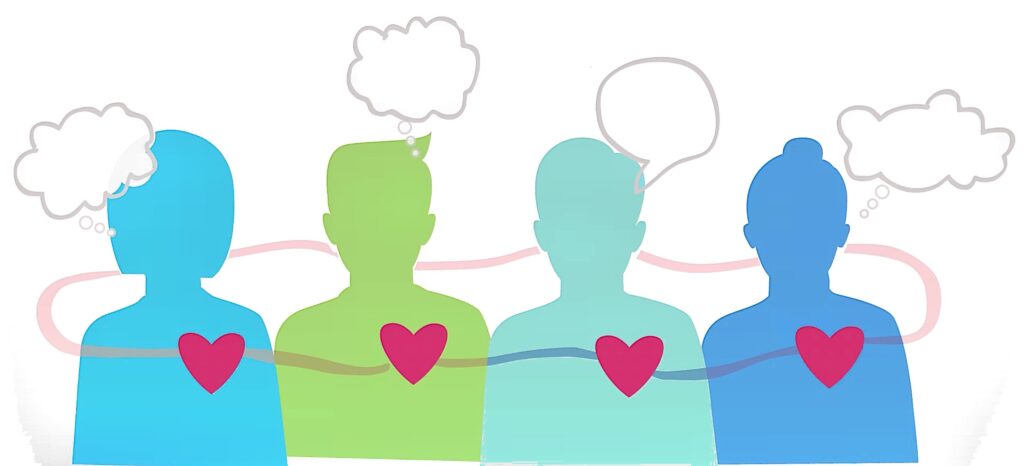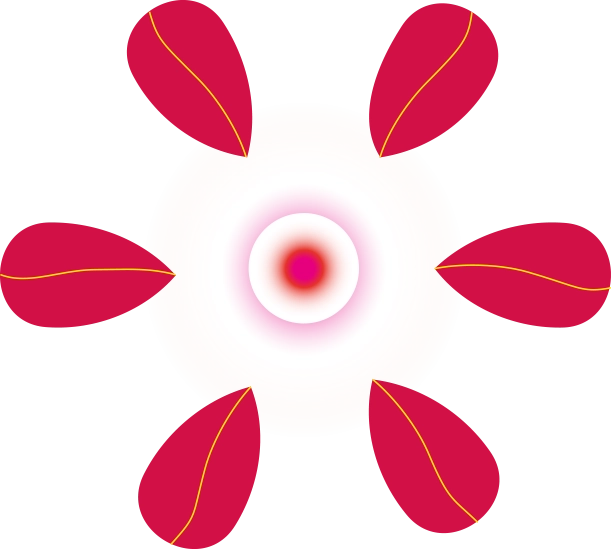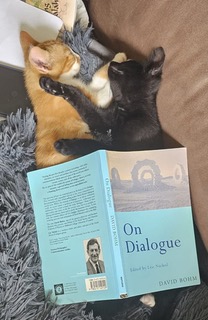door Hugo Skoppek, augustus 2023
Opening Thoughts
This article was written in response to a question from a colleague of the Dialoog Netwerk Nederland “Hoe creëer je een bedding voor een Bohmiaanse dialoog?
At first, I did not consider myself competent enough to respond to such a request, since I had not studied Bohm that intensely. However, having read some of the responses from my colleagues, I felt inspired to re-visit Bohm’s writings and compare his findings with my own experiences.
So I took a closer look at the question: “How do you create a context or setting for a (Bohmian) dialogue?” On the one hand it could be understood as wanting to learn more about possible alternatives, i.e. in terms of more options how it could be done. On the other hand, it could mean a search for the ‘perfect’ setting in order to achieve a successful dialogue. I don’t think that I can respond to either or these interpretations, because no matter how many possible methods or techniques you may know to facilitate a dialogue, you are likely to find yourself in a unique conversation where none of these may apply. And if there was indeed a ‘perfect’ answer, it would preclude any creativity and freedom which I personally consider to be at the heart of dialogue.
Also the term ‘bedding’ may evoke different imaginations or meanings in different people: Bohm refers to its as ‘an open, free and empty space’, probably influenced by Jiddu Krishnamurti’s saying “The cup has to be empty to hold something . This corresponds very much with ‘vrije ruimte’ used by the trio Jos Kessels, Erik Boers and Pieter Mostert. William Isaacs coined the term ‘container’, while Martin Buber refers to it as ‘Zwischen’. Others interpret it as a safe space, a basket, a listening chamber, etc. or compare it to a river bed. As far as I am concerned, it does not matter what we call it. What all these metaphors have in common is a focus on what holds and not on what is being held.
Bohm also used the metaphor of the flowing stream or river to describe the “Undivided Wholeness in Flowing Movement” aka ‘stream of consciousness’. Bohm was well aware of “the notion that reality is to be understood as process is an ancient one, going back at least to Heraclitus “Panta rhea”
It also struck me that Bohm frequently mentions Alfred Korzybski’s statement: “Whatever we say a thing is, it isn’t. … For the thing is always more than what we mean … and the thing is also different from what me mean.”
I consider the riverbed as a metaphor for context as self evident, Korzybski’s statement may be more obscure. I shall return to it again in the end.
Differentiating Context
Let’s take a look at context of dialogue in the widest possible sense. Like the flourishing of a plant depends on local soil conditions, access to water, interaction with animals (particularly pollinators), as well as planetary influences, so may a dialogue be influenced by a variety of different aspects.
For the purpose of this article, I have sorted them into five groups, namely conception, the physical environment, structural arrangements, sensitive awareness and being present. While these groups can be clearly described in theory, practice shows that there are no distinct boundaries between between them, but gradual, i.e. flowing transitions from one to another. They should not be considered as categories, but as different landscapes we may encounter as we follow the flow of a river.
Conception
Conception may not be the most obvious to come to mind, when we speak about the context of and for dialogue. I have decided to include it here, because I experience that the way we visualize a dialogue to be has a potent influence on the flow and quality of the conversation. It is impossible to address all the details under this heading, as everything that is mentioned under the subsequent heading, can, of course, also be visualized.
Suffice it to emphasize here that is of vital importance to be crystal clear about target audience, i.e. who the dialogue is for, what the topic of the conversation is (most likely an underlying question to be answered) and the type of dialogue that is most suitable to serve that purpose.
Regarding the latter, I find Martin Buber’s differentiation extremely helpful. He recognizes a factual dialogue, an educational/therapeutic dialogue, and a fully mutual dialogue. As their names suggest, they all serve different purposes.
The factual dialogue (also referred to as a technical dialogue) occurs in any work situation where people focus on a common task in order to solve problems in the external world. In the educational or therapeutic dialogue this focus shifts from the external object to the development or healing of another subject, a human being. In these kind of dialogues the relationships are not equal, but can be respectively described as human over matter or human over another human. While the human being in the educational/therapeutic dialogue is able to engage in the conversation in a co-creative manner, she surely lacks the knowledge or experience of the teacher she is subject to or of the therapist she has turned to for help.
Buber describes the fully mutual dialogue as an encounter of mature and equal human beings free of any purpose to solve problems in the material world or care for the body or soul of another human being. I understand this to be similar to what Bohm had in mind, when he refers to the bands of hunter-gatherers when they came together to talk with “no apparent agenda nor any predetermined purpose,” i.e. a ‘dialogue’ where one is required to shed personal and cultural infrastructures so as to allow a person to engage in ‘talk’ about an idea, a concept, an issue, a concern, in a setting that eschews fear and agendas and what has become widely and popularly known as talking ‘circles.’ This kind of dialogue may not have any concrete purpose related to an expected outcome, but a purpose that expresses itself in a creative process such as in research, experiment or play.
Physical Environment:
It is easy to assume that physical aspects will be obvious to anybody, but I witness too many situations, where the physical environment is not really suited to having a fruitful conversation. By the physical environment I mean the space where the conversation takes place. Does the conversation take place outside in the open or is it being contained in a room? Being out in the open usually means more distractions due to traffic noise or the sounds of birds, etc. A room usually affords a quieter environment. But is the room big enough to seat everybody comfortably. Are the chairs comfortable to sit on for an extended period of time. Is the room bright enough to see each other? What is the room climate like? i.e. the air-quality, the room temperature, background noises?
Are appliances (black- or white-board, beamer, audio- or video-equipment, etc.) and materials (paper, pens, name badges, etc.) in good working order? Is there sufficient wall space to post the agenda or other notes and or drawings? Are drinking water and glasses easily available? Where are the toilets? Is the room aesthetically pleasing? We speak differently in a bleak basement room with small windows compared to a harmoniously decorated room with high ceilings and a view across a lake with snow covered mountains in the background.
Structural Arrangements
While the presence of comfortable chairs belongs to the physical aspects, the way the chairs are arranged falls under structural aspects. This was an issue during corona. Due to the safe distance requirement a room that usually could accommodate 20 people, barely afforded sufficient space for 10. Also, how are the chairs organized? Around a table or in a circle? Have you, as the organizer or facilitator chosen a chair from which you can easily oversee the entire room (or most of it) and the entrance door? Can everybody see the flipchart or screen? Can the temperature easily be adjusted? Can the windows be opened to let in fresh air?. Can disturbing appliances be switched off?
As a facilitator you are responsible to maintain a structure to achieve the objective of the conversation. In the first instance this may mean what is the objective of having the conversation: Are we just gathering information, exploring options, weighing the pros and cons of a possible solution, are we in the process of making a decision or negotiating a conflict. All these aspects demand a slightly different way of being dealt with. You may want to outline the necessary structure in a prepared agenda or draaiboek to serve as a reference or compass for the participants during the conversation. Depending what may be become aware of or sense (see the following heading) it may be necessary to add change or delete certain aspects of the agenda or script to ‘go along with the emerging flow’. Maintaining a clear understandable structure is essential so people know what is going on and what is expected of them.
In the beginning of a conversation, particularly when participants do not know each other, it is a good practice to allow every participant the same amount of uninterrupted time to speak. This gives introverts a sense of safety and time to think, while extroverts will have an opportunity to stop thinking and really listen instead. Incorporating small, but frequent breaks helps balancing these differences if they become a challenge.
Moments of silence allow participants to discover deeper levels of the conversation. So plan for them. They often make for a rewarding transition.
Sensitive Awareness
So far we have described the tangible physical environment and how we can arrange and manipulate it for the most fruitful outcome of the dialogue. What I mean by sensitive awareness is primarily related to the people involved in the dialogue. And irrespective of whether you are the facilitator or a participant, we can become aware of sensations that originate from other participants, as well as sensations that arise within ourselves. In theory this differentiation is easily described and understood, but in practice, it often happens that we (unconsciously) react to what other people say or how they say it – and before we know it, the other has reacted, too – and we may be just a simple misunderstanding escalates quickly into a conflict. When it comes to developing sensitive awareness, I found the works of Marshall Rozenberg extremely helpful. The four elements of non-violent communication are easily understood, but require continuous practice to apply them effectively in real life situations. What makes practicing sensitive awareness so essential is the fact, that we are usually not fully conscious of what we perceive, think, feel or do. As a result we often react quickly without taking time to reflect. However, “between stimulus and response there is a space. In that space is our power to choose our response. In our response lies our growth and our freedom.” I believe that recognizing this space is essential to understanding and practicing Bohm’s explicit indications related to suspension and proprioception.
Suspension
To get to this space, Bohm proposes to suspend our assumptions, so that we neither carry them out, nor suppress them.
This – again – is easier said than done. The context of the physical environment and the structural arrangements can be easily described and clear instructions can be given to implement them. Regarding the sensitive awareness, this is not so. Irrespective of how well I may be able to describe them, to be able to implement them requires practice. This is no longer about passing on knowledge, but about learning new skills such as sound judgment and discernment.
I was fortunate to have been part of a group of dialogue practitioners that came together 2-3 times a year to practice dialogue. I was even more fortunate that the group was dominated by two members who ‘interfered’ in a way that was (at least in the beginning) not always appreciated. Interestingly enough, their ‘contributions’ were on the opposite side of a scale. On the one hand was a successful business man who intimidated the group on many occasions with emotional outbursts when he considered something irrational or not to his liking – on the other hand was an experienced business coach who impressed the group with his immediate, unsolicited analysis and explanations of a situation before other participants had a chance to fully realize what had happened.
These (and other incidents) had two effects. One on an individual level, another on the group level. When Bohm talks about suspension, he is primarily concerned with becoming aware of our own assumptions, reactions and automatisms and encourages us to suspend so that they do not disturb the group process. This type of suspension is indeed up to each individual and may even pass unnoticed by the other group members. However, the disturbing behavour of the two members described above were collectively felt and, following Ruth Cohn’s principle “disruptions have priority,” were collectively addressed. In effect we suspended the group process in order to deal with the individual disturbance (not the disturbing individual). There was a distinct shift from of talking about dialogue, to engaging in dialogue about what had happened between us. So we acknowledged the frustration, tried to free them of any personal charge and tried to understand the underlying issues. Bohm refers to the necessity of dealing with frustrations on several occasions “We have to share the consciousness that we actually have. We can’t just impose another one”. (emphasis in original text).
Instead of addressing frustrations in the entire group, we sometimes found it helpful to engage in one-on-one conversations in which we could ‘mirror’ each other more easily and learn from our different perspectives. Taking a genuine interest in each other and asking vital questions played an important role in learning from any disruptive encounters.
Practicing suspension in concrete real life situations was a valuable learning experience and demonstrated the fact that “The point of suspension is to help make proprioception possible …”
Proprioception
Proprioception usually describes the sensation of body position and the movement of limbs by means of sensory perceptors. When Bohm borrows the term to also include the proprioception of thought, I find it difficult to follow him. On the one hand he appears more abstract and theoretical, on the other hand he denies that there is a distinct observer . Still, in his own intuitive manner he points towards the importance of (physical) feelings and that we may become aware of “what thought is” by practicing attention.
Let’s take a moment to consider the meaning of ‘feeling’ in a Bohmian manner: In Germanic languages, the primary meaning refers to our sense of touch by which we sense the world around us. Other sensations relate to more inner perceptions, i.e. feeling warm or cold, well or ill, hungry or thirsty, pleasure or pain, etc. We also speak of emotions as feeling afraid, angry, happy, sad, etc. In relation to other people, we feel compassion, empathy, love, etc. And then there are moments when we feel that we have understood something without fully realizing what it is or how to put it into words. Such a hunch or inkling often finds clarification in an Eureka moment, when suddenly something new is revealed to us. As far as I am concerned this “Aha” moment may not yet be thinking, but clearly marks a transition from felt to mental experiences.
These examples show we employ the word ‘feeling’ in many different contexts and that it has a wide spectrum of meanings that go further than our five ordinary senses – or at least beyond how we usually make use of them.
When I was a student I came across a chapter in a book entitled “Inviting Anger in for Tea”. The author described the wisdom of emotions and what we can learn from them. The first lesson was to just be with your emotions instead of ignoring or fighting them – similar to what Rumi describes in his poem ‘The Guest House’:
This being human is a guest house.
Every morning a new arrival.
A joy, a depression, a meanness,
some momentary awareness comes
as an unexpected visitor.
Welcome and entertain them all!
Even if they are a crowd of sorrows,
who violently sweep your house
empty of its furniture,
still, treat each guest honorably.
He may be clearing you out
for some new delight.
The dark though, the shame, the malice,
meet them at the door laughing,
and invite them in.
Be grateful for whoever comes,
because each has been sent
as a guide from beyond.
This sounds so paradox compared to how we usually conduct ourselves, but this message has served me well over the years to deal with stress, frustration, and other emotions. When I was younger, I took “time out” from confronting situations or conflicts at work. Often this proved sufficient to re-engage in a situation with a different, clearer mindset.
While taking “time out” served me as a good beginning, it is not enough to fully tap into the wisdom of emotions (or feelings). Over the years, I signed up for workshops to learn about handling stress, communication, body language, empowerment, leadership, change management, presentation skills, coaching, etc. Most of these workshops were knowledge focussed in so far as they taught certain methods and techniques, but failed to provide the experience as to when to apply them.
This changed when I met with the group of dialogue practitioners mentioned above. Instead of being satisfied with various theories, we wanted to know whether we could actually experience (i.e. feel) what an author was talking about? Could we recognize the elements of a particular theory in the actual interaction between ourselves? You could say that we were doing action research.
Among other things we discovered more subtle feeling hiding behind our basic emotions of anger, fear, joy, and sorrow. It took a substantial investment in time, a genuine interest in each other and a concerted effort to recognize the underlying feelings, acknowledge their existence and – as Rumi says – “welcome and entertain them all!” Luckily, we had developed a substantial amount of emotional credit amongst us that allowed us to talk about issues that had emerged between two or more people in the group itself and reflect on the same from a meta position.
Interestingly enough, it was only when people stopped clinging to their original emotion as a right and defending it as such that they could sense any underlying feelings. These ‘lasting moments’ were often marked by a striking stillness while the other participants simply sat there and held the space. It seemed like a paradox: By allowing themselves to be vulnerable, people actually seemed to discover their strength. This silence and holding the space for somebody else is beautifully captured in the movie “Ray”, when his mother refrains from helping him up after having fallen down, thus allowing him to rely on his other senses. When these moments of silences occurred in the dialogue group, they also led to new insights, not just for the ‘speaker’, but also for the people holding the space. And like in the movie scene, these moments were followed by some form of relief – from something overwhelming to something liberating.
It could be argued that all this has nothing to do with proprioception in the Bohmian sense, because it relates to ordinary sense perception. Such an objection would indeed be justified. However, whatever people experienced in these silences was also accompanied by physical feelings that we are usually not very aware of it. Bohm describes these as “the heartbeat, blood pressure, the way you breathe, the way your body feels tense; and also the thoughts that go along with it.” I would argue that these changes in body functioning can be read and understood as a stimulus to make us aware of something else. Clearly, this is not always immediately apparent, but it we learn to become aware of these changes, we can consciously pause and investigate their possible meaning. I was recently intrigued by the title of a little book “Your body knows the answer” and found it very helpful to get a sense of my feelings beneath my feelings. Again, this may not what Bohm had in mind as ‘proprioception of thought’, but I found it helpful in being becoming aware of and being able to suspend automatic reflexes, assumptions, preferences, prejudices and the like. And being able to sustain my own reactions, helps me to contain those of others. In this sense I want to conclude that the ultimate bedding for a dialogue is that which each person is able to hold and sustain.
Being Present
Bohm observed a widespread fragmentation in the world, not only in society as a whole, but also in each individual, that he believed caused “a general confusion of the mind, which creates an endless series of problems and interferences with our clarity of perception so seriously as to prevent us from being able to solve most of them. This assessment echos Einstein’s warning “that a new type of thinking is essential” in the atomic age “if mankind is to survive and move toward higher levels.”.
Bohm was convinced that suspending our assumptions, prejudices, habitual reflexes, etc., and that being able to feel the wisdom of our body are essential to get us to these higher levels of consciousness. He elaborates how abstract thought can lead us astray, whereas tacit knowledge (i.e. the wisdom of the body) has the ability to get us back into balance. It is not only important what we think, but how we think.
So how do we change our thinking? There is an old saying that “you must change your thinking and become like little children.” Zen practitioners refer to this as a ‘beginner’s mind’, that allows us to see and hear things as if for the first time (as if we are suspending all previous knowledge). Pretend to be a child who knows nothing and questions everything. Such an original mindset implies that we also approach any participants as if they know nothing, because assuming or suspecting that they do would indicate prior knowledge (in this case ‘false’ knowledge) on our part.
If you find yourself reacting strongly to what somebody has said or done, chances are that you are no longer perceiving with an open mind, but are stimulated by your own pre-existing ideas. This is the time to suspend that stimulus and allow the space to open from which you can freely choose your response.
Suspending our past experiences also requires us to suspend any roles, functions, positions, achievements, awards, honors, etc. and meet as bare human beings. We need to perceive and recognize each other as equals. Any hierarchy in a dialogue refers to an existing world view that has nothing in common with the curiosity of the ‘beginner’s mind’. Engaging as equals means to be honest with each other and not present ourselves in a particular manner (neither as a kind idealist, nor as a powerful achiever), but be as who we truly are. That demands an enormous amount of courage, because we may experience this as being exposed and standing naked and vulnerable in front of others.- And yet, the courage to say ‘yes’ to who we are in those moments has a balancing effect on the situation, as if the speaker is invited or even aided by the listener to express a profound insight which even may cause the speaker to wonder what has just been said.
It appears to me that in moments like these the naive authenticity of the speaker meets with the true interest of the listener. This changes the quality of the dialogue as well as the relationship between the people and of each individual at the same time.
One of the ways to bring about such moments are described by Stephen Covey as empathic listening that “gets inside another person’s frame of reference. You look out through it, you see the world the way they see the world, you understand their paradigm, you understand how they feel.” According to David Henry Thoreau this is truly awe-some: “Could a greater miracle take place than for us to look through each other’s eyes for an instant?” Since we may not have the luxury of time to wait for miracles, we have to do the work in order to develop the necessary skills. So Covey continues “you listen with your ears, but you also, and more importantly, listen with you eyes and with your heart. You listen for feeling, for meaning. You listen for behavior. You use your right brain as well as your left. You sense, you intuit, you feel. … You have to open yourself up to be influenced”. What Covey means by ‘sense, intuit, feel’ is pretty much in line of Bohm’s proprioception as a necessary skill, i.e. a power of discernment and sound judgment to better understand each other.
Irrespective of the best preparation, the most beautiful physical, the most thought through agenda and extensive training in awareness, you will find yourself in situations that are challenging, because they do not go as anticipated. That’s life. However, this is where the power of discernment and sound judgement come into play.
Let me illustrate this with an example: I was asked to organize an interactive workshop for a women’s business association who wanted to learn more about sustainability. I talked with three of their board members and we decided on a plan that consisted of a brief presentation, in-depth conversations in small breakout groups based on mutual interest with a concluding plenary session to share the findings from the small groups and conclude.
At the time of the event it turned out that the participants were not interested in any brief presentation, neither in small group discussions, but wanted to explore the subject collectively among themselves in a group of about 25 people. Of course, I had some strong (internal) reactions to this newly emerged situation. I felt irritated confused, and uncomfortable and angry with the people for not adhering to the agreed upon agenda. At the same time I knew that insisting to proceed as planned would have the same effect on the keen energy in the room as a pin would have on a balloon.
So I stood there being stripped of all my crutches (i.e. everything I had prepared for that evening). I remember sweating and having a hard time swallowing. – I panicked within myself: “Now what?” – And this is exactly what I asked the participants: “Now, what is it you want to do.” Instead of carrying out my responsibility as agreed on paper, I was asked to show my response-ability in practice.
It turned out that we engaged in a lively conversation about a wide variety of aspects ranging from environmental concerns to technical options to feasible solutions, to social inequality, to economic models, to the well-being of society to the role we could each play in the situation we are in. Although we officially concluded the workshop on time, almost half of the people stayed on afterwards and continued the conversation over drinks.
I know for sure that I did not make a conscious rational decision to proceed that evening, but acted, on what I call intuition. I am confident that this is what Bohm describes as the tacit process or tacit knowledge.
Closing Thoughts
The purpose of this essay was to elaborate on how to create a bedding for Bohmian dialogue. I hope that I was able to shed some light on the issue. However, I do want to remind ourselves that we have focussed on ‘what holds and not on what is being held’.
This resonates strongly with the comment of a colleague from the Dialoog Netwerk Nederland “the river makes the bed and the bed makes the river”. This is certainly true for actual rivers that have not been technically manipulated. It was also true for my flow of consciousness while writing this article. In the process I experienced a continuous alternating movement between sticking to the subject matter of ‘context’ and following my fascination of Bohm’s writing. In this sense I had a first-hand experience of “the bed makes the river and the river makes the bed.” I know that I have allowed myself to drift further on some occasion than sticking strictly to the subject of context. Some readers may experience this as drifting afield, others may appreciate the additional information. Still, I hope that all readers will appreciate the meaningful context of the whole that I have tried to convey.
Bohm himself invites us to “consider the entire stream at once.” For some that may mean from the source to the ocean, for me this includes the entire hydrological cycle. Water evaporates from the oceans, enters the atmosphere and drops back onto our planet as rain, hail and snow. Bohm describes that “the essential flow is not from one place to another, but a movement within the implicate and superimplicate (generative) orders”. And that “because of the possibility of loops, the flow may go in a pair of opposite ‘directions’ at the same time.” To Bohm the reference to the stream is only an image for higher levels of consciousness. While Bohm’s approaches these higher levels of consciousness through physics, Goethe does the same through poetry when he talks about the Spirits over the Waters
The soul of man
Is like water:
It comes from heaven,
And it returns to heaven,
And down again
To the earth it must,
Forever changing.
Remember “Whatever we say a thing is, it isn’t. … For the thing is always more than what we mean … and the thing is also different from what me mean.”
Or using Bohm’s words instead: “Truth does not emerge from opinions; it must emerge from something else – perhaps from a more free movement of the tacit mind.” “Therefore you have to watch out for the notion of truth. Dialogue may not be concerned directly with truth – it may arrive at truth, but it is concerned with meaning.” “In … dialogue we share all the roads and we finally see that none of them matters. We see the meaning of all the roads and therefore we come to the ‘no road.’ Underneath, all the roads are the same because of the very fact that they are ‘roads’ – they are rigid.”
Notes
David Bohm, On Dialogue, 1996, page 17
Jos Kessels, Erik Boers and Pieter Mostert, Vrije Ruimte, 2002
This ‘Zwischen’ has been translated as ‘The Between’ or ‘Betweenness’ in English. What Buber refers to here is the space that opens up when two (or more) people truly meet, i.e. a unique space that is full of potential.
David Bohm, Wholeness and the Implicate Order, London, 1980; page 11
Bohm and Peat, Science, Order and Creativity, New York, 1987; page 126
Ibid, page 48
‘Panta Rhei’ = everything flows; a phrase frequently used by Jiddu Krishnamurti with whom Bohm had a close, collaborative relationship
Ibid; page xvi
As described in Gerda Sutter, Wirklichkeit als Verhältnis, 1972, (Dritter Teil, pages 149-186)
Since most problem solving occurs in groups, it is indeed important to focus on the on the process of problem solving which Bohm describes thus “The point would not be to identify with the group, but rather, what is important in this whole process. You might say ‘This is a wonderful group,’but it’s actually the process what counts.” (italics are mine); David Bohm, On Dialogue, 1996, page 18
David Bohm, Donald Factor, Peter Garrett; Dialogue – A Proposal, 1981, page 3
David Bohm, On Creativity, 1996, page viii
David Bohm, On Dialogue, 1996, page 30
Nancy Kline, Time To Think,1999,
Observation, feelings, needs and requests.
This quote is usually attributed to Stephen R. Covey, but the idea has most likely originated with Thomas Walton Galloway or Rollo May.
David Bohm, On Dialogue, 1996, page 20
David Bohm, On Dialogue, 1996, pages 19, 31-33
David Bohm, Donald Factor, Peter Garrett; Dialogue – A Proposal, 1981, page 4, 5, 7 + 8
https://paricenter.com/bohmian-psychology-the-undiscovered-continent-of-david-bohms-worldview 5th paragraph from the bottom (accessed on 30th June 2023)
David Bohm, On Dialogue, 1996, pages 20, 25
ibid
As indicated by the use of ‘somehow’, ‘perhaps’, ‘possibly’, ‘we cannot tell exactly’, ‘another approach could be’, etc. David Bohm, On Dialogue, 1996, page 75 and 76
ibid
I am not elaborating on these issues, because they do not affect my thinking about “Dialogue in Context.
In other languages ‘feeling’ can also relate to seeing (Urdu) or hearing (Italian).
Unfortunately, I do no longer remember the author, nor the title of the book. If you know about said book, please let me know.
Jalāl al-Dīn Rūmī and Coleman Barks,. The Essential Rumi, San Francisco, 2004, page 109
https://www.youtube.com/watch?v=hkmvuV6PK20&t=162s, accessed 26th August 2023
David I. Rome, Your Body Knows the Answer, 2014
compare with’feelings’ and ‘felts’ in David Bohm, On Dialogue, 1996, page 53
Albert Einstein, quoted in New York Times, 25th May 1946, page 13
David Bohm, On Dialogue, 1996, page 14
Matthew, 18:3
Stephen R. Covey, The 7 Habits of Highly Effective People, 1989; page 240
The question “How do we gain knowledge of what is going on inside other people?” is beautifully elaborated on in E.F. Schumacher, A Guide for the Perplexed, 1977; page 81
Ibid,
Both these meanings of ‘skill’ are now obsolete. I have chosen to use the expression anyway, because the original meaning conveys exactly what I am trying to say here. Today ‘skill’ is often referred to in a more technical context, which, by the way, has also been differentiated by Stephen Covey
https://www.etymonline.com/search?q=skill accessed 30th August 2023
Bohm also describes suspension and proprioception as necessary skills for a scientist in order to arrive at a more coherent understanding of the world.
David Bohm, On Dialogue, 1996, page 14
Bohm and Peat, Science, Order and Creativity, New York, 1987; page 195
Johann Wolfgang von Goethe, Goethe’s Werke, Berlin/Weimar, 1868, Band I, page 99 (translated by the author)
David Bohm in On Dialogue, 1996, page 35
Ibid, page 37
Ibid, page 38
